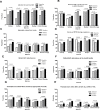Evaluation of a community-based intervention to improve maternal and neonatal health service coverage in the most rural and remote districts of Zambia
- PMID: 29337995
- PMCID: PMC5770027
- DOI: 10.1371/journal.pone.0190145
Evaluation of a community-based intervention to improve maternal and neonatal health service coverage in the most rural and remote districts of Zambia
Erratum in
-
Correction: Evaluation of a community-based intervention to improve maternal and neonatal health service coverage in the most rural and remote districts of Zambia.PLoS One. 2018 Jul 2;13(7):e0200324. doi: 10.1371/journal.pone.0200324. eCollection 2018. PLoS One. 2018. PMID: 29966010 Free PMC article.
Abstract
Background: A community-based intervention comprising both men and women, known as Safe Motherhood Action Groups (SMAGs), was implemented in four of Zambia's poorest and most remote districts to improve coverage of selected maternal and neonatal health interventions. This paper reports on outcomes in the coverage of maternal and neonatal care interventions, including antenatal care (ANC), skilled birth attendance (SBA) and postnatal care (PNC) in the study areas.
Methodology: Three serial cross-sectional surveys were conducted between 2012 and 2015 among 1,652 mothers of children 0-5 months of age using a 'before-and-after' evaluation design with multi-stage sampling, combining probability proportional to size and simple random sampling. Logistic regression and chi-square test for trend were used to assess effect size and changes in measures of coverage for ANC, SBA and PNC during the intervention.
Results: Mothers' mean age and educational status were non-differentially comparable at all the three-time points. The odds of attending ANC at least four times (aOR 1.63; 95% CI 1.38-1.99) and SBA (aOR 1.72; 95% CI 1.38-1.99) were at least 60% higher at endline than baseline surveillance. A two-fold and four-fold increase in the odds of mothers receiving PNC from an appropriate skilled provider (aOR 2.13; 95% CI 1.62-2.79) and a SMAG (aOR 4.87; 95% CI 3.14-7.54), respectively, were observed at endline. Receiving birth preparedness messages from a SMAG during pregnancy (aOR 1.76; 95% CI, 1.20-2.19) and receiving ANC from a skilled provider (aOR 4.01; 95% CI, 2.88-5.75) were significant predictors for SBA at delivery and PNC.
Conclusions: Strengthening community-based action groups in poor and remote districts through the support of mothers by SMAGs was associated with increased coverage of maternal and newborn health interventions, measured through ANC, SBA and PNC. In remote and marginalised settings, where the need is greatest, context-specific and innovative task-sharing strategies using community health volunteers can be effective in improving coverage of maternal and neonatal services and hold promise for better maternal and child survival in poorly-resourced parts of sub-Saharan Africa.
Conflict of interest statement
Figures
Similar articles
-
Can people-centered community-oriented interventions improve skilled birth attendance? Evidence from a quasi-experimental study in rural communities of Cambodia, Kenya, and Zambia.BMC Pregnancy Childbirth. 2020 Sep 5;20(1):514. doi: 10.1186/s12884-020-03223-0. BMC Pregnancy Childbirth. 2020. PMID: 32891128 Free PMC article.
-
Predictors of Antenatal Care, Skilled Birth Attendance, and Postnatal Care Utilization among the Remote and Poorest Rural Communities of Zambia: A Multilevel Analysis.Front Public Health. 2017 Feb 9;5:11. doi: 10.3389/fpubh.2017.00011. eCollection 2017. Front Public Health. 2017. PMID: 28239604 Free PMC article.
-
Prevalence and determinants of maternal healthcare utilisation among young women in sub-Saharan Africa: cross-sectional analyses of demographic and health survey data.BMC Public Health. 2022 Apr 5;22(1):647. doi: 10.1186/s12889-022-13037-8. BMC Public Health. 2022. PMID: 35379198 Free PMC article.
-
Community mobilization to strengthen support for appropriate and timely use of antenatal and postnatal care: A review of reviews.J Glob Health. 2021 Dec 30;11:04076. doi: 10.7189/jogh.11.04076. eCollection 2021. J Glob Health. 2021. PMID: 35003714 Free PMC article. Review.
-
Pragmatic indicators for remote Aboriginal maternal and infant health care: why it matters and where to start.Aust N Z J Public Health. 2010 Jul;34 Suppl 1:S5-8. doi: 10.1111/j.1753-6405.2010.00545.x. Aust N Z J Public Health. 2010. PMID: 20618295 Review.
Cited by
-
Contribution of community health care volunteers in facilitating mobilization for diabetes and hypertension screening among the general population residing in urban puducherry - An operational research study.J Family Med Prim Care. 2022 Feb;11(2):638-643. doi: 10.4103/jfmpc.jfmpc_1316_21. Epub 2022 Feb 16. J Family Med Prim Care. 2022. PMID: 35360780 Free PMC article.
-
Implementation of a community-based intervention in the most rural and remote districts of Zambia: a process evaluation of safe motherhood action groups.Implement Sci. 2018 May 31;13(1):74. doi: 10.1186/s13012-018-0766-1. Implement Sci. 2018. PMID: 29855324 Free PMC article.
-
Correction: Evaluation of a community-based intervention to improve maternal and neonatal health service coverage in the most rural and remote districts of Zambia.PLoS One. 2018 Jul 2;13(7):e0200324. doi: 10.1371/journal.pone.0200324. eCollection 2018. PLoS One. 2018. PMID: 29966010 Free PMC article.
-
Predictors of Health Seeking Behaviours for Common Childhood Illnesses in Poor Resource Settings in Zambia, A Community Cross Sectional Study.Front Public Health. 2021 May 19;9:569569. doi: 10.3389/fpubh.2021.569569. eCollection 2021. Front Public Health. 2021. PMID: 34095039 Free PMC article.
-
Factors affecting home delivery among women living in remote areas of rural Zambia: a cross-sectional, mixed-methods analysis.Int J Womens Health. 2018 Oct 5;10:589-601. doi: 10.2147/IJWH.S169067. eCollection 2018. Int J Womens Health. 2018. PMID: 30349403 Free PMC article.
References
-
- Zambia Central Statistical Office, the DHS Program, ICF International, Rockville, Maryland, USA. Zambia demographic and health survey 2013–14. Lusaka Zambia, the DHS Program, ICF International, Rockville, Maryland, USA, Macro: September, 2014. http://dhsprogram.com/pubs/pdf/FR304/FR304.pdf (accessed 02 March 2017)
-
- UNDP. Zambia Millenium Development Goals Progress Report. United Nations Development Programme, Lusaka: 2005.
-
- Mpembeni RN, Killewo JZ, Leshabari MT, Massawe SN, Jahn A, Mushi D, et al. Use pattern of maternal health services and determinants of skilled care during delivery in Southern Tanzania: implications for achievement of MDG-5 targets. BMC Pregnancy Childbirth. 2007; 7:29 doi: 10.1186/1471-2393-7-29 - DOI - PMC - PubMed
-
- Mekonnen Y, Mekonnen A. Utilization of maternal health care services in Ethiopia. 2002
Publication types
MeSH terms
Grants and funding
LinkOut - more resources
Full Text Sources
Other Literature Sources
Medical


